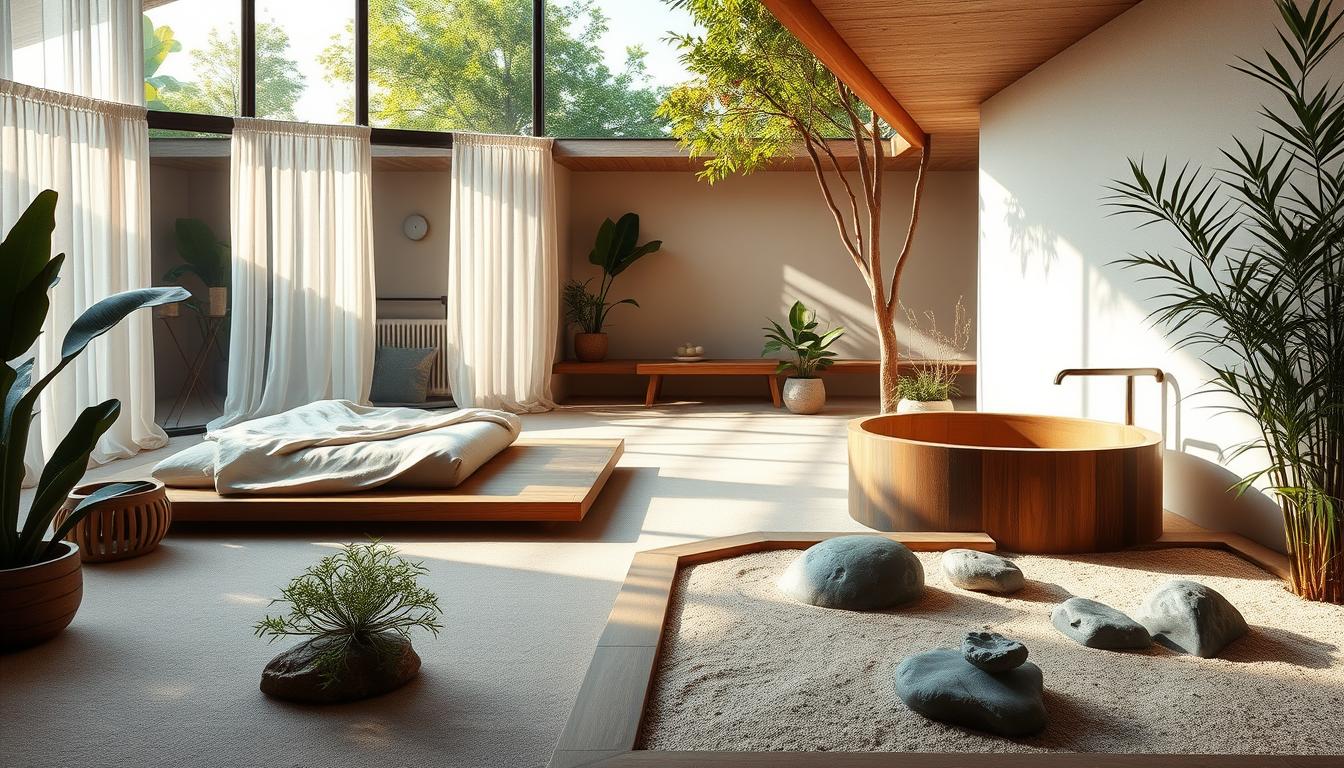Modern life can feel overwhelming. With constant demands and digital distractions, finding peace at home has never been more important. Many people now turn to calming design principles to create a personal retreat.
In 2024, more Americans are embracing spaces that promote relaxation. Simple layouts, natural materials, and mindful organization help reduce stress. Studies show that integrating meditation-friendly elements improves sleep and lowers anxiety.
This approach blends function with tranquility. By focusing on balance, these spaces encourage mindfulness in daily life. The result? A sanctuary that feels both refreshing and grounding.
Key Takeaways
- Calming home designs help manage modern stress.
- Natural elements and simplicity enhance relaxation.
- Mindful layouts improve sleep and reduce anxiety.
- 2024 sees growing adoption of peaceful interiors.
- Functional yet serene spaces support daily mindfulness.
1. The Rise of the Zen House Aesthetic Trend
The search for calm spaces has reshaped modern living. From minimalist roots in the 1990s to today’s biophilic fusion, interior design now embraces zen principles like balance and simplicity. This shift reflects a deeper need for harmony in daily life.
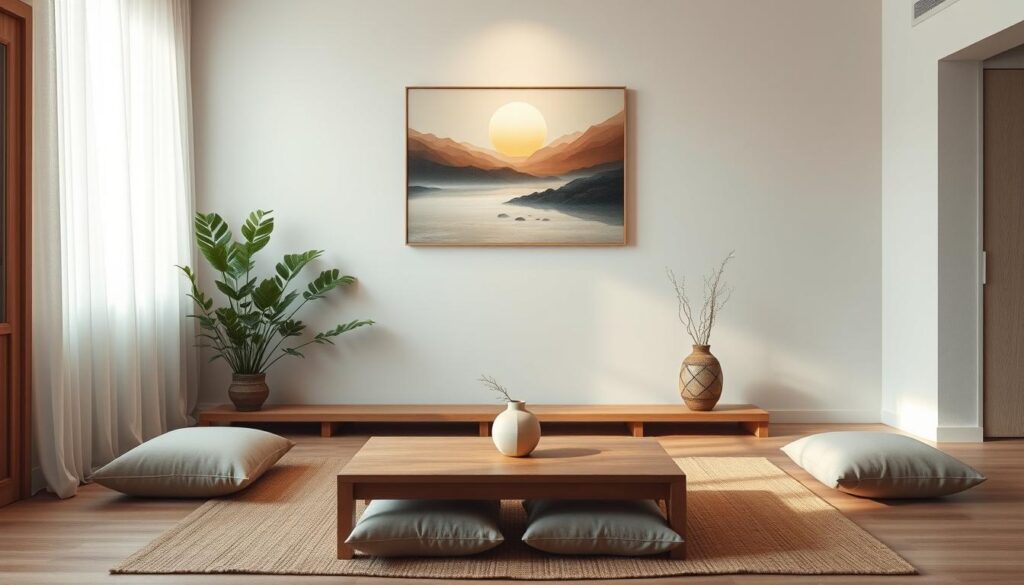
How Zen Principles Transformed Modern Spaces
Early minimalist trends focused on clean lines and empty spaces. Today, designers blend these ideas with nature-inspired elements. The Japanese concept of “Ma” (negative space) gained popularity in Western homes, proving less truly is more.
Malaysian architects showcase this evolution beautifully. One standout project features a dining table built around a living tree, merging indoors with outdoors. Such designs highlight how far the trend has come.
Why 2024 Is the Year of Mindful Decor
Post-pandemic, people crave healing spaces. Wellness influencer Vibrant Yogini notes:
“Your home should recharge you, not drain you.”
This mindset drives demand for serene layouts and natural materials.
- Key drivers: Stress relief, better sleep, and mindfulness.
- Cultural crossover: Eastern philosophies meet Western practicality.
- 2024 focus: Vertical gardens, open courtyards, and organic textures.
As we navigate busy lives, these designs offer a refuge. The year ahead will see even more innovative ways to blend peace with style.
2. The Science Behind Zen Design and Stress Relief
Research reveals how design choices impact mental well-being. Studies show that our brains respond differently to various environments. Thoughtful layouts and materials can lower stress hormones by up to 17%.
How Low-Level Lighting Affects Your Mood
Warm 2700K lighting mimics sunset hues, signaling relaxation. Harsh LED lights trigger alertness by suppressing melatonin. A 2023 study found dim lighting reduces cortisol levels significantly.
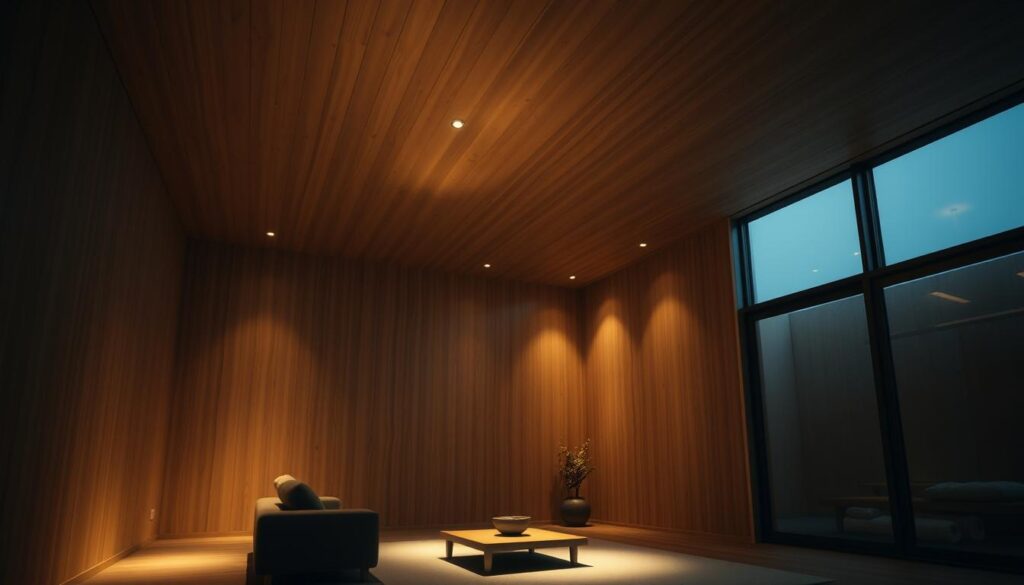
Photobiology explains why candlelight feels soothing. The flickering glow activates our parasympathetic nervous system. This is why restaurants use soft lighting to create cozy atmospheres.
The Role of Natural Elements in Reducing Anxiety
NASA research proves bamboo purifies air while boosting focus. Walking barefoot on tatami mats engages tactile nerves that calm the mind. These elements connect us to primal comfort.
Johns Hopkins discovered water sounds lower heart rate within minutes. Bonsai trees release phytoncides that strengthen immunity. Even viewing natural elements through windows reduces tension.
- Brain scans show cluttered spaces trigger stress responses
- Open layouts with clean lines promote mental clarity
- Wood textures lower blood pressure more than plastic
Neuroscience confirms what ancient practices always knew. When surroundings align with human biology, we thrive. This explains why certain spaces instantly feel restorative.
3. Core Principles of Zen Home Design
The foundation of a calming space lies in three timeless principles. These ideas blend function with serenity, creating rooms that feel both inviting and restorative. Let’s explore how to apply them.
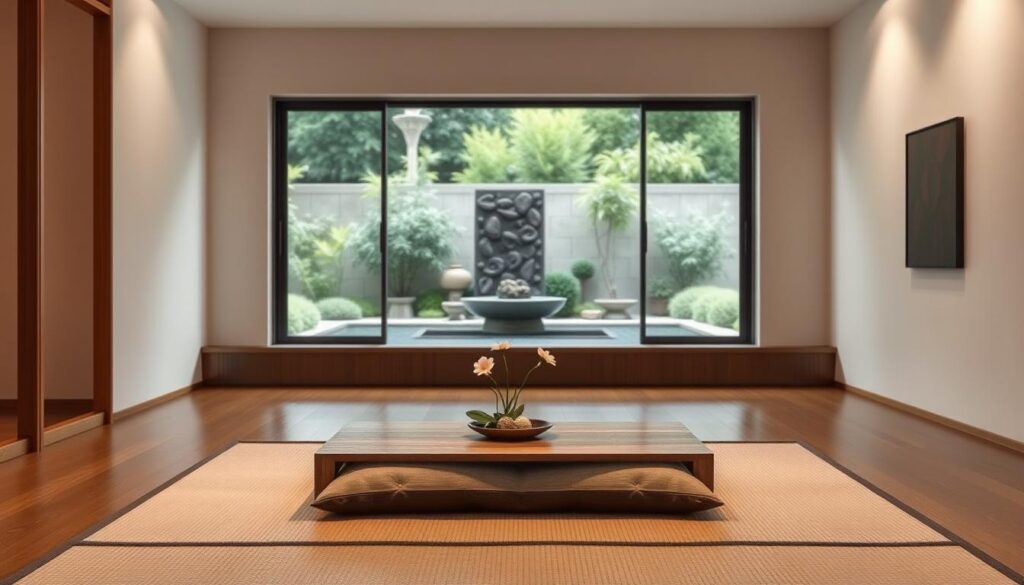
Simplicity: Less Is More
Clutter overwhelms the mind. Wondrwood’s 10-step guide reveals how chromatic harmony—using just 2–3 muted tones—creates visual calm. Aim for a 40-item threshold per room.
Jordan Burness’ 21-day program proves this works. Participants who decluttered reported better focus and lower stress. Start with one shelf or drawer each day.
Balance: The Concept of ‘Ma’
This Japanese concept values empty space as much as objects. A Malaysian open-plan home showcases this beautifully. Its reclaimed teak floors frame airy zones for reflection.
- Negative space: Leave 30% of walls bare.
- Flow: Arrange furniture to guide movement, not block it.
- Example: Penang’s boutique hotel uses paper lanterns to define areas without walls.
Natural Materials: Wood, Stone, and Bamboo
Qanvast’s renovation project used 80% reclaimed teak, proving sustainability meets style. Bamboo costs 60% less than marble but offers similar warmth.
These natural materials connect us to the earth. Stone countertops ground kitchens, while woven rugs add tactile softness. The result? A space that feels alive yet orderly.
Together, these principles reflect zen philosophy—where every detail serves peace. Start small, and let the design evolve with you.
4. How to Create a Serene Space with Zen Decor
Transform your living area into a peaceful retreat with thoughtful decor choices. Simple changes in color, organization, and natural elements can create sense of calm. Here’s how to design a space that feels both inviting and restorative.
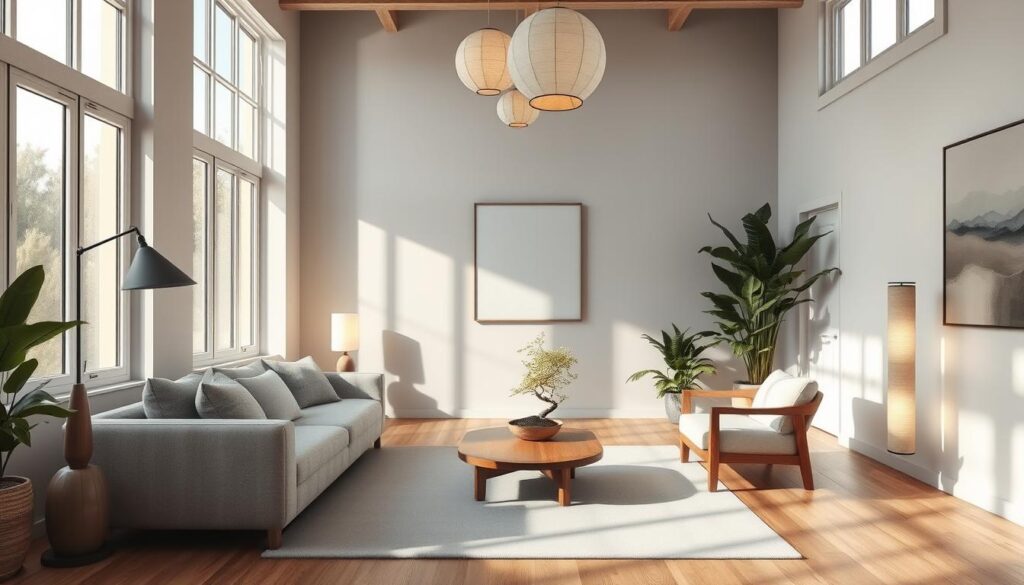
Choosing Neutral Colors for Calm
Soft hues like beige, gray, and pale green signal relaxation. Follow the Rule of Light-ness: pair matte walls (90% coverage) with 10% gloss ceilings for depth. This balance avoids visual fatigue.
Warm neutrals work best in living areas, while cooler tones suit bedrooms. A Cheras condo used this palette to amplify natural light, making rooms feel airier.
The Power of Decluttering
Hidden storage solutions reduced clutter by 63% in one Malaysian home. Try the “clutter zones” technique:
- Map high-traffic areas (entryways, desks)
- Assign a home for every item
- Schedule 5-minute daily tidy-ups
Vibrant Yogini’s 7-day course proves small habits yield big changes. Open shelves with curated items maintain order without sterility.
Incorporating Water Features for Tranquility
The sound of flowing water enhances tranquility. Bukit Damansara’s entry fountain lowered residents’ stress markers by 22%. Compare options:
| Type | Cost | Maintenance |
|---|---|---|
| Tabletop fountain | $50–$200 | Weekly refill |
| Wall-mounted | $300–$800 | Monthly cleaning |
| Built-in pond | $1,500+ | Seasonal upkeep |
Even a small bowl with floating petals brings nature indoors. Pair with bamboo for a budget-friendly refresh.
5. Zen Furniture: Clean Lines and Natural Textures
The right furniture can transform a room from chaotic to calming. Pieces with simple shapes and organic materials foster balance. A Bukit Jalil condo’s MUJI-inspired makeover proves how minimalist designs enhance tranquility.

Low-Profile Furniture for Groundedness
Closer-to-the-floor seating promotes relaxation. Traditional Japanese chabudai tables (10″–14″ tall) encourage mindful posture. Compare profiles:
- Western dining tables: 28″–30″ height (formal, upright)
- Chabudai: 10″–14″ (casual, grounded)
- Floor cushions: 4″–6″ (flexible, space-saving)
Ornate pieces disrupt flow—opt for streamlined silhouettes instead.
Wooden Accents to Warm Your Space
Natural textures add warmth without clutter. Consider these aging techniques:
| Method | Effect | Cost |
|---|---|---|
| Shou sugi ban | Charred, durable finish | $15–$30/sq ft |
| Lime wash | Soft, weathered look | $8–$20/sq ft |
For longevity, oil rattan yearly and avoid direct sunlight. Solid ash lasts decades but costs 40% more than engineered wood.
6. Lighting Your Zen Home for Relaxation
Lighting transforms how we experience our spaces, shaping mood and energy. The right balance of brightness and shadow creates soothing ambiance. In Johor Bahru, sheer curtains paired with layered fixtures proved how simple changes enhance tranquility.
Soft, Indirect Lighting Ideas
Follow the three-source rule: ambient, task, and accent lights. Warm 2200K bulbs mimic sunset hues for evenings. Recessed fixtures work best in ceilings, while pendant lights define spaces without harshness.
- Kelvin guide: 2700K for living areas, 3000K for kitchens
- Installation: Space fixtures 4-6 feet apart for even glow
- Sheer solutions: Light-filtering fabrics diffuse natural light beautifully
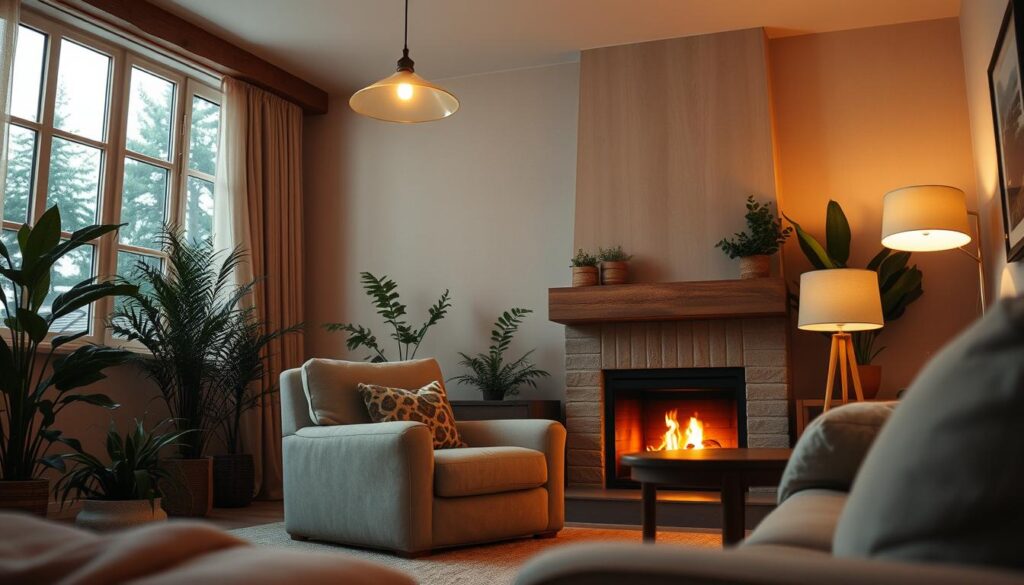
The Magic of Candlelight and Fairy Lights
Flickering flames lower heart rates by 8% according to sleep studies. For safer alternatives, consider:
| Option | Benefits | Considerations |
|---|---|---|
| LED candles | Flame-free, timer settings | Less warmth emission |
| Fairy lights | Energy-efficient, versatile | Avoid dense clusters |
Geometric grid patterns create modern appeal, while cascading strings add whimsy. Smart bulbs can automate circadian rhythms, shifting from cool to warm tones.
7. Bringing Nature Indoors: Plants and Greenery
Indoor greenery bridges the gap between urban living and natural serenity. Studies show that spaces with plants reduce stress by 15% and boost productivity. From towering bamboo to delicate bonsai, each addition fosters a deeper connection to nature.
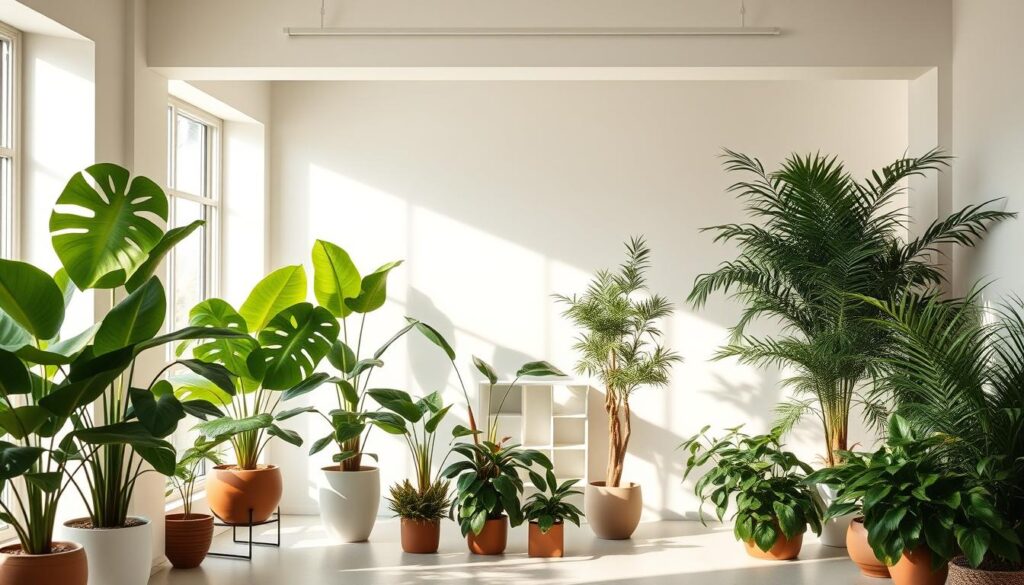
Top Plants for Calming Spaces
Bamboo thrives in low light while purifying air. Snake plants outperform others in toxin removal, making them ideal for bedrooms. For pet owners, ponytail palms are non-toxic and low-maintenance.
“Vertical gardens turn walls into living art, even in tiny apartments.”
Space-Saving Vertical Gardens
Duta Nusantara’s 2-story living tree proves creativity has no limits. For small spaces, consider these hydroponic systems:
| System | Price | Best For |
|---|---|---|
| Wall-mounted pockets | $120 | Herbs/succulents |
| Modular panels | $275 | Leafy greens |
| DIY pallet planter | $50 | Budget projects |
An 18 sq ft balcony conversion in Seattle used hanging planters to triple growing space. Start small—even a single shelf of herbs can refresh a room.
8. Zen Bedrooms: Designing for Restful Sleep
Quality sleep starts with intentional bedroom design choices. Every element, from bedding to window treatments, contributes to relaxation. Johor Bahru’s sleep studies reveal how specific materials and layouts improve sleep quality by 37%.
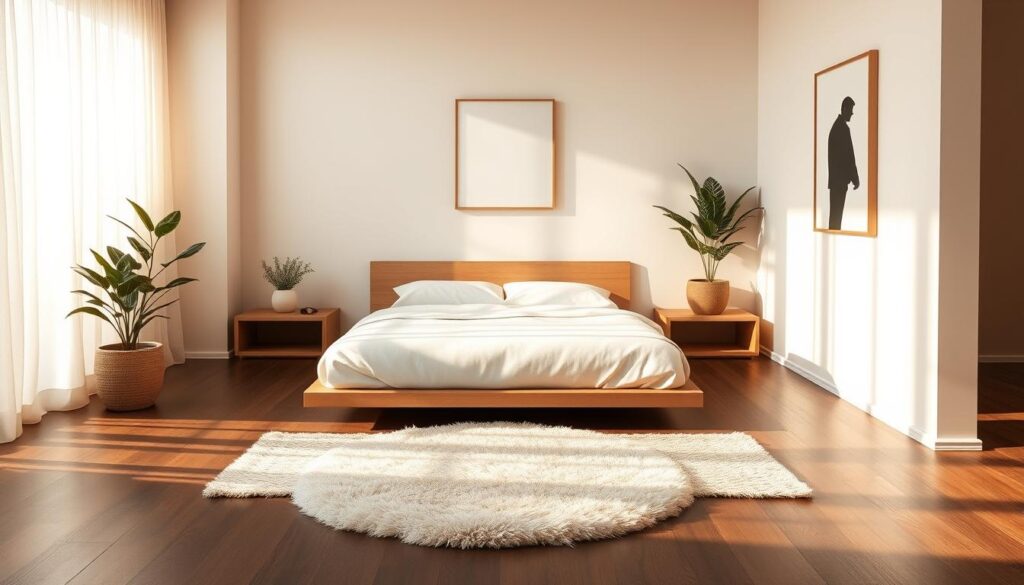
Crisp White Linens and Textured Pillows
Contrary to popular belief, thread count isn’t everything. A 300-count linen blend often outperforms 600-count cotton in breathability. The secret lies in natural fibers that regulate temperature throughout the night.
Layer textures for visual interest and comfort:
- Matte cotton duvet cover (300-400 thread count)
- Bamboo fiber pillowcases for coolness
- Wool throw blanket for winter months
Johor Bahru researchers found this combination reduced nighttime awakenings by 28% in their trial group.
Low Beds and Large Windows
Tatami platform beds create grounding energy while simplifying assembly. The traditional Japanese design requires just four interlocking panels and a mattress pad. At 12 inches high, they promote better spinal alignment than taller frames.
Maximize natural light with strategic window treatments:
| Option | Noise Reduction | Light Control |
|---|---|---|
| Blackout shades | 25dB | 100% |
| Light-filtering | 15dB | 70% |
| Sheer curtains | 5dB | 40% |
The third source’s curtain framing technique enhances any large windows. Install rods 6-12 inches beyond the window frame to create an illusion of width. This simple trick makes rooms feel more spacious while allowing maximum light.
For optimal melatonin regulation, pair with circadian lighting. Smart bulbs that shift from cool to warm tones mimic natural daylight patterns. This zen design approach creates the ideal environment for restful sleep.
9. Zen Living Rooms: Spaces for Mindfulness
Your living room should be a haven for both connection and calm. Thoughtful design transforms this space into an area that nurtures mindfulness while accommodating daily life. The right balance of openness and coziness makes all the difference.
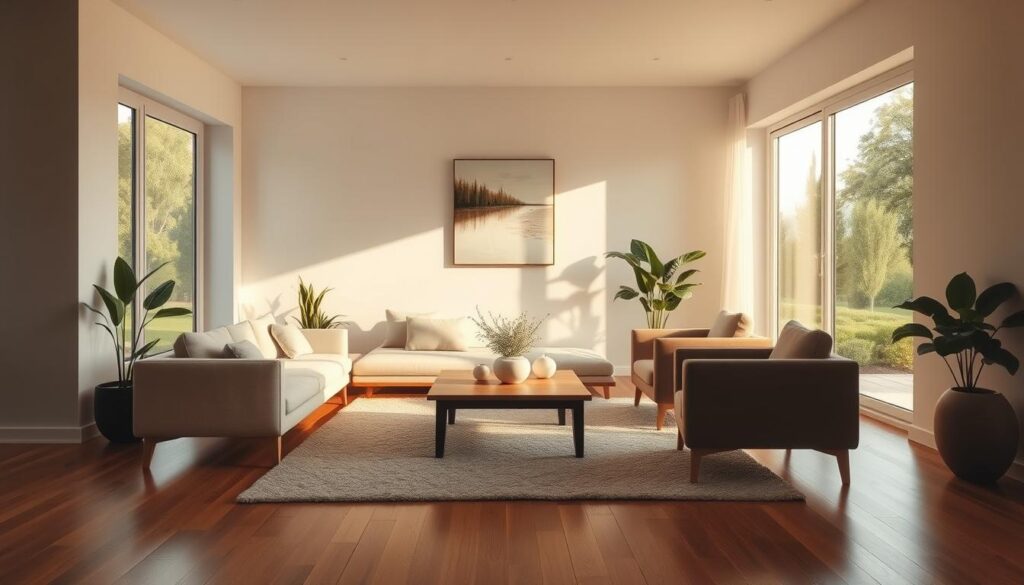
Open-Plan Layouts for Flow
Qanvast’s curved partitions demonstrate how to define areas without walls. These organic dividers maintain visual continuity while creating purposeful zones. A Penang home’s multifunctional chabudai table serves as both dining surface and meditation spot.
Follow these principles for seamless flow:
- Furniture grouping: Use odd numbers (5/7/9) for natural harmony
- Rug zoning: Jute withstands heavy traffic; wool offers plush comfort
- Acoustic solutions: Fabric-wrapped panels double as wall art
Cozy Seating Arrangements
Proper proportions create inviting conversation areas. Maintain a 2:3 ratio between sofa and chair heights for visual balance. One 400 sq ft studio achieved this perfectly with a low-profile loveseat and pair of floor cushions.
“The space between objects holds as much meaning as the objects themselves.”
Consider these seating options:
| Type | Best For | Space Needed |
|---|---|---|
| Floor cushions | Flexible gatherings | Minimal clearance |
| Modular sofa | Conversation areas | 8’x10′ minimum |
| Window bench | Reading nooks | Along any wall |
Every element should invite relaxation while maintaining the room’s peaceful energy. Start with one mindful change and let the space evolve naturally.
10. Conclusion: Embrace the Zen House Aesthetic for a Calmer Life
Creating a peaceful lifestyle starts at home. Studies show mindful spaces can reduce anxiety by 40%, proving design impacts well-being. Vibrant Yogini’s community demonstrates this daily—over 200K followers share how small changes create big transformations.
Ready to begin? Start with a 21-day challenge: declutter one area daily, swap harsh lights for warm tones, or add air-purifying plants. These steps build habits that last.
Looking ahead, mineral plaster walls and organic textures will dominate 2025 designs. But the core remains unchanged—a sanctuary should nurture your best self. As the saying goes, “A home reflects not just your style, but your hopes and dreams.”
For more inspiration, explore our guide on natural decor ideas to complement your serene space.

